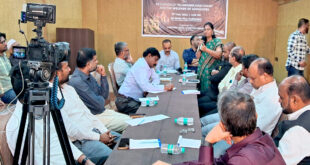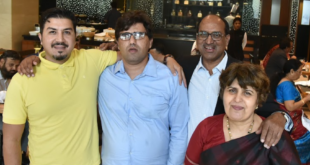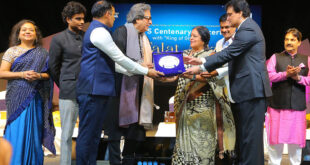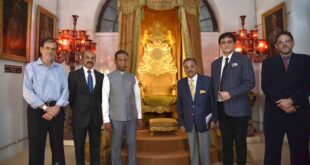Urdu and Hyderabad are so deeply related that the mere mention of the two together reels imagination of Darbaris unfurling the Payam Namas to enunciate the Shaahi farmaans on royal decree and the rebounding sounds of poetry and Qawwali resonating in the majestic arched imperial palaces the Qutub Shahis and the Nizams endured. In a more contemporary aspect, Urdu is a soulful form of beautiful linguistic art, ornamental poetry at the pinnacle of lexical best, and one of the most influential cosmopolitan languages in existence.
The historical perspective, depicting the inception and evolution of Urdu and Urdu journalism, is even more interesting and captivating than it would once seem. The charismatic charm, the opulence of vocabulary, the cogence in depicting varied moods and personalities with commendable elegance, and the simplicity in presentation of facts has helped Urdu establish itself as the lingua franca of the both plebeian and elite sections of the society, paving way for expedited growth of Urdu journalism.
Inception:
Although the general imitation about Urdu is that it was born in Delhi as a language of soldiers, its historical lineage traces back to Hyderabad which remains its epicentre owing to the Bahmani Sultanate of Deccan, the Kakatiyas and Qutubshahi rulers. In the Indian sub-continent, Urdu nurtured in the period of Jahangir, and eventually became a language spoken across the length and breadth of the country.
While Urdu is an evolved language, it is not too old. Throughout its period of evolution, Urdu was referred by different names such as Hindavi, Zuban-e-Delhi and even Rekhta (meaning mixed speech). Deccani in the Deccan Plateau and Gajari in Gujarat are geographically inspired labels of Urdu.
It was in year 1809 that Cool Brooke officially differentiated between Hindi and Urdu and Hindustani. Amir Khusrau, in his Masnavi (a form of poetry) ‘Na Sapahar’ labelled the agglomeration of Sindhi, Lahori, Kashmiri, Dogiri, Dhor Samadri or Tamil, Telangi or Telugu, Gujari or Gujarati, Gori or Pahadi, Bangla or Bengali, Avadhi and Dehalvi languages as Hindavi.
Legendary poet Mir Taqi Mir and poet-and-biographer Mir Hasan in their books also tagged the languages used in the-then India as Hindavi. The Arabs, according to linguist John Gilchrist (1759-1841), referred all dialects of India as Hindi or Hindiya.
In summary, the amalgamation of Persian and Dravadian languages gave birth to the Deccan language Urdu, and it splendidly grew, even in Delhi.
The Meaning of Urdu
In Turkish, Ordu means ‘lashkar’ meaning ‘army’. Another linguist named Mr I.I.Qazi observed that Urdu is not an original Turkish word, and proclaimed it as synonymous with ‘crowd’ or ‘congregation’ in Sindhi.
In ancient Norwegian mythology, ‘Urdu’ or ‘Urth’ is the name of a goddess of fate. ‘Urd’ is also the oldest word in Aryan language and the word ‘Urdu’ used today, according to a different theory, was abstracted from this word.
In an incongruent expression, Mehmood Sheerani, historian poet and linguist claims that Urdu means ‘royal camp’ in Turkish language while Dr. Ikram Turkaman, defined it as ‘Milandi’. In its transition to the modern times, it is only natural that Urdu, as we know today, is a perennially refined and curated product of these changes in time.
Urdu Journalism in Hyderabad
In Hyderabad, the city’s founder ruler Quli Qutub Shah of the Qutub Shahi Dynasty laid the foundation for Urdu literature. He also became the first poet of Deccani dialect. In the 15th century, there was an official communicator called ‘Darabari- Akbhar Navees’. Communication through this medium is the first form of journalism noted in that period. During the 18th century, Farsi was the official language of the state and in 19th century, Asif Jahi rulers gave Urdu the precedence as an official language, taking the first step towards ensuring the growth of Urdu language and Urdu journalism in the Deccan plateau.
The growth of Urdu in the erstwhile state Hyderabad due to its patronage from the government and also from the intelligentsia during the 19th century and the emergence of Urdu newspapers during the Asif Jahi period is axiomatic of the rebellious mood espoused by Urdu journalism since the beginning. There were some newspapers which carried the Farmaan (decree) of the government and there were some who stood for democracy.
Journalism, in literary context, is a medium of communication between the newsmakers, leaders and the masses. Journalism grew as the fourth pillar in democracy. True to its meaning ‘lashkar’, Urdu soon became a language of groups and eventually a language of communal harmony.
This article is part of an elaborate research-based series on Urdu Journalism : Past, Present and Future
Stay tuned. To be continued…
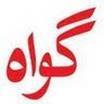 Gawah (The Witness) – Latest News, Current Affairs, Politics, Sports, Religion, Literature, Technology, Education, National, Local – Hyderabad Telangana India World Fearless By Birth, Pristine by Choice – First National Urdu Weekly From South India – Latest News, Breaking News, Special Stories, Interviews, Islamic, World, India, National News
Gawah (The Witness) – Latest News, Current Affairs, Politics, Sports, Religion, Literature, Technology, Education, National, Local – Hyderabad Telangana India World Fearless By Birth, Pristine by Choice – First National Urdu Weekly From South India – Latest News, Breaking News, Special Stories, Interviews, Islamic, World, India, National News

